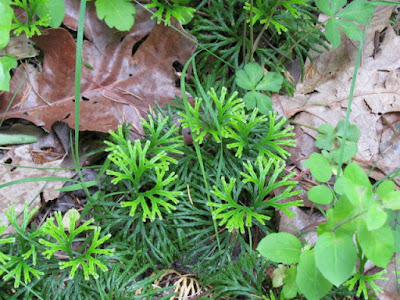On a recent (June 2012) camping trip in Southern Illinois my husband Mark kept taking pictures of non-flowering plants. His pictures made the ferns, mosses, lichens, and club moss look like something right out of a fairytale. In fact, these non-flowering plants do have their very own kingdom in the plant world. Instead of reproducing by flowers and seeds, these plants use spores to multiply. We were all particularly amazed by the various mosses.
While hiking I discovered a large patch of club moss. I had never seen it before. Club mosses are ancient, prehistoric plants that reproduce by means of spores, either clustered into small cones or in the axils of their scale like leaves. I suspect that the one I saw was a ground pine because it resembled miniature evergreens with flattened fan-shaped branches. For a plant-geek like me this was an amazing find!
Club Moss
There are more than 13,000 species of
mosses, which are small, primitive, leafy, green plants that develop fine,
tangled mats over a surface. Various species are often seen on old brick walls,
stone paths or walls, roofs, and rocks. Moss is something that we seem to love
or hate. Many people try to get rid of it in their lawns, while others try to
grow it.
In the right place, I love the look of moss. It is natural and in the right combination with wildflowers and other native plants helps create a stunning landscape. Psychologically, moss has a soothing, relaxing effect on people. It is a natural component of woodlands and shade gardens.
Mosses grow where other plants won’t, preferring low soil fertility, poor soil drainage, compacted soils, excessive shade, poor air circulation, high humidity, or a combination of these conditions. Mosses are not always found in low pH soils, thus altering the soil pH may not eliminate mosses. In turf, mosses are not the cause of turf decline, but a symptom of environmental or management levels that are unsuitable for supporting quality turf.
For areas where you do not want the moss, it can be eliminated, at least temporarily, by hand raking when it first appears or by applying ferrous ammonium sulfate or ferric sulfate. Remember, however, that moss will probably reappear unless the environment and/or turf management program is altered.
For areas where you do want moss, the basic requirements are shade; compact, bare, acid soil; and moisture. The best time for transplanting is in early spring. Once established, moss is a tough plant. It is hardy from zones 2 to 9 and able to survive severe drought.
Although we often try to control and manipulate Mother Nature, sometimes “she” really knows best. Although I do not believe in gardening exclusively with natives, I believe native habitats tell us an awful lot. Sometimes it is worth considering “giving in” to situations where a certain plant wants to grow. Moss is a good example. It is a good alternative to grass in shady areas and in the right location can be used very effectively.
Originally Published in Canton Daily Ledger Column on 6-2-2012








